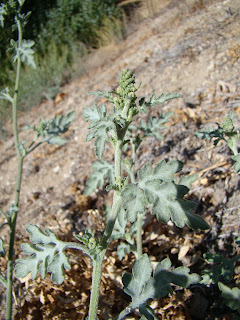Ambrosia artemisiifolia
Ambrosia artemisiifolia or comon ragweed is the most widespread species of Ambrosia. I have already written about silver burr ragweed (Ambrosia chamissonis). Indeed you can see close resemblance between two different species of the same genus Ambrosia. The leaves look very similar and the tassels of flowers are common to both. But Ambrosia chamissonis grows mainly on the sea coast while Ambrosia artemisiifolia is common on the dry land. It does not mind the hot climate. Beach variety is also more prostrate while common ragweed plants grow tall.
Common ragweed flowers
The name artemisiifolia is given to the plant because the leaves resemble those of a related genus Artemisia (wormwood or sagebrush). The smell is also somewhat similar though Ambrosia have tougher leaves and bigger flowers (still very small though) that are green or yellow. An interesting thing about common ragweed is that it is supposed to be one of the major culprits of hay fever though I personally never suffered from this particular plant.
Like Artemisia, Ambrosia belongs to the Aster family (Asteraceae).










